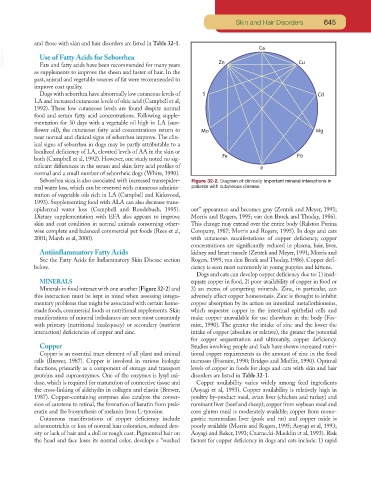Page 623 - Small Animal Clinical Nutrition 5th Edition
P. 623
Skin and Hair Disorders 645
and those with skin and hair disorders are listed in Table 32-1.
VetBooks.ir Use of Fatty Acids for Seborrhea
Fats and fatty acids have been recommended for many years
as supplements to improve the sheen and luster of hair. In the
past, animal and vegetable sources of fat were recommended to
improve coat quality.
Dogs with seborrhea have abnormally low cutaneous levels of
LA and increased cutaneous levels of oleic acid (Campbell et al,
1992). These low cutaneous levels are found despite normal
food and serum fatty acid concentrations. Following supple-
mentation for 30 days with a vegetable oil high in LA (sun-
flower oil), the cutaneous fatty acid concentrations return to
near normal and clinical signs of seborrhea improve. The clin-
ical signs of seborrhea in dogs may be partly attributable to a
localized deficiency of LA, elevated levels of AA in the skin or
both (Campbell et al, 1992). However, one study noted no sig-
nificant differences in the serum and skin fatty acid profiles of
normal and a small number of seborrheic dogs (White, 1990).
Seborrhea sicca is also associated with increased transepider- Figure 32-2. Diagram of clinically important mineral interactions in
mal water loss, which can be reversed with cutaneous adminis- patients with cutaneous disease.
tration of vegetable oils rich in LA (Campbell and Kirkwood,
1993). Supplementing food with ALA can also decrease trans-
epidermal water loss (Campbell and Roudebush, 1995). out” appearance and becomes gray (Zentek and Meyer, 1991;
Dietary supplementation with EFA also appears to improve Morris and Rogers, 1995; van den Broek and Thoday, 1986).
skin and coat condition in normal animals consuming other- This change may extend over the entire body (Ralston Purina
wise complete and balanced commercial pet foods (Rees et al, Company, 1987; Morris and Rogers, 1995). In dogs and cats
2001; Marsh et al, 2000). with cutaneous manifestations of copper deficiency, copper
concentrations are significantly reduced in plasma, hair, liver,
Antiinflammatory Fatty Acids kidney and heart muscle (Zentek and Meyer, 1991; Morris and
See the Fatty Acids for Inflammatory Skin Disease section Rogers, 1995; van den Broek and Thoday, 1986). Copper defi-
below. ciency is seen most commonly in young puppies and kittens.
Dogs and cats can develop copper deficiency due to: 1) inad-
MINERALS equate copper in food, 2) poor availability of copper in food or
Minerals in food interact with one another (Figure 32-2) and 3) an excess of competing minerals. Zinc, in particular, can
this interaction must be kept in mind when assessing integu- adversely affect copper homeostasis. Zinc is thought to inhibit
mentary problems that might be associated with certain home- copper absorption by its action on intestinal metallothioneins,
made foods, commercial foods or nutritional supplements. Skin which sequester copper in the intestinal epithelial cells and
manifestations of mineral imbalances are seen most commonly make copper unavailable for use elsewhere in the body (Fos-
with primary (nutritional inadequacy) or secondary (nutrient mire, 1990). The greater the intake of zinc and the lower the
interaction) deficiencies of copper and zinc. intake of copper (absolute or relative), the greater the potential
for copper sequestration and ultimately, copper deficiency.
Copper Studies involving people and foals have shown increased nutri-
Copper is an essential trace element of all plant and animal tional copper requirements as the amount of zinc in the food
cells (Brewer, 1987). Copper is involved in various biologic increases (Fosmire, 1990; Bridges and Moffitt, 1990). Optimal
functions, primarily as a component of storage and transport levels of copper in foods for dogs and cats with skin and hair
proteins and cuproenzymes. One of the enzymes is lysyl oxi- disorders are listed in Table 32-1.
dase, which is required for maturation of connective tissue and Copper availability varies widely among feed ingredients
the cross-linking of aldehydes in collagen and elastin (Brewer, (Aoyagi et al, 1993). Copper availability is relatively high in
1987). Copper-containing enzymes also catalyze the conver- poultry by-product meal, avian liver (chicken and turkey) and
sion of carotene to retinal, the formation of keratin from prek- ruminant liver (beef and sheep); copper from soybean meal and
eratin and the biosynthesis of melanin from L-tyrosine. corn gluten meal is moderately available; copper from mono-
Cutaneous manifestations of copper deficiency include gastric mammalian liver (pork and rat) and copper oxide is
achromotrichia or loss of normal hair coloration, reduced den- poorly available (Morris and Rogers, 1995; Aoyagi et al, 1993;
sity or lack of hair and a dull or rough coat. Pigmented hair on Aoyagi and Baker, 1993; Czarnecki-Mauldin et al, 1993). Risk
the head and face loses its normal color, develops a “washed factors for copper deficiency in dogs and cats include: 1) rapid

